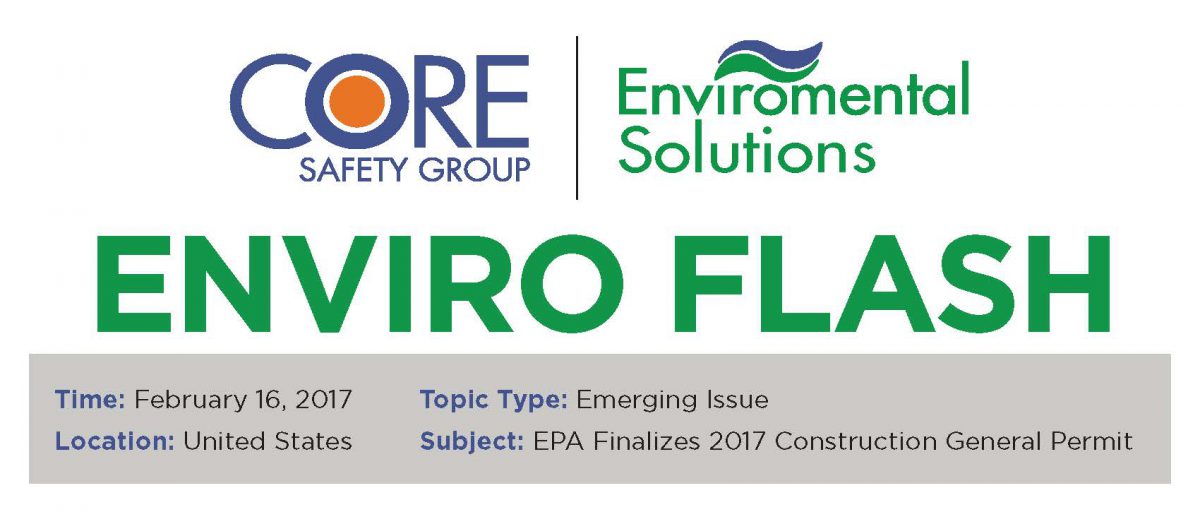
The U.S. EPA published its final 2017 Construction General Permit (CGP), which takes effect on February 16, 2017, the same date as the expiration of the 2012 CGP. The 2017 permit includes several new or modified requirements, summarized below, which will impact affected construction projects located in portions of the U.S. where EPA is the permitting authority. These changes may also be reflected in state-level permit programs as they come up for renewal.
1. NOI & NOT Submittals: Site operators are now required to electronically prepare and submit NOIs and NOTs to start and stop permit coverage. Some states (GA, NE, OR and RI) have announced that they will require the use of EPA’s eReporting Tool when they reissue their construction stormwater permits. Other states are expected to follow suit. EPA also added 3 questions to the NOI form that will aid in the determination of new requirements.
2. Authorized Discharges: The 2017 CGP contains an explicit prohibition of non-stormwater discharges of external building washdown waters containing hazardous substances such as paint or caulk containing PCBs.
3. Notice of Permit Coverage: An additional requirement has been added to the existing Notice of Permit Coverage that must be posted at a safe, publicly accessible location in close proximity to the construction site. This notice must also include information informing the public of how to contact the EPA to obtain a copy of the SWPPP or if stormwater pollution is observed in the discharge.
4. Stockpiles & Land Clearing Debris Piles: EPA changed the requirement for temporary stabilization for stockpiles or land clearing debris piles from “where practicable” to requiring cover or appropriate temporary stabilization for all inactive piles that will be unused for 14 or more days.
5. Construction and Domestic Waste: EPA now requires operators to keep waste container lids closed when not in use and at the end of the business day for containers that are actively used throughout the day, and to provide effective cover for waste containers without lids.
6. Stabilization Deadlines: EPA modified the approach to stabilization deadlines based on the concept of phasing construction disturbances. Deadlines are based on total amount of land disturbance occurring at any one time.
- Five acres or less – Immediately stabilize any area of exposed soil where construction activities have permanently ceased or will be temporarily inactive for 14 or more calendar days. Complete installation of stabilization measures as soon aspracticable, but no later than 14 days after initiated.
- More than 5 acres – Follow the same initiation schedule. However, complete installation of stabilization measures as soon as practicable, but no later than 7 calendar days after initiation.
IMPACTS of these CHANGES:
1. Is my project located in an area where EPA is the permitting authority?
The following states and territories fall under EPA authority:
- Idaho, Massachusetts, New Hampshire, New Mexico, and the District of Columbia;
- Indian country lands within Alabama, Alaska, Arizona, California, Colorado, Connecticut, Florida, Idaho, Iowa, Kansas, Louisiana, Massachusetts, Michigan, Minnesota, Mississippi, Montana, Nebraska, Nevada, New Mexico, New York, North Carolina, North Dakota, Oklahoma, Oregon, Rhode Island, South Dakota, Texas, Utah, Virginia, Washington, Wisconsin, and Wyoming;
- Areas within Colorado, Delaware, Vermont, and Washington are subject to construction by a federal operator
2. What does it mean if my project is not located in one of these areas?
States in which EPA has delegated authority to manage their own NPDES permitting programs must ensure their programs are at least as stringent as the federal program. Like EPA, states reissue their CGPs periodically, but not necessarily on the same schedule. Therefore, it is important to recognize that states will likely update their requirements in subsequent CGP revisions to reflect the new standards issued in EPA’s 2017 CGP.
3. What do I need to do as a result of the CGP updates?
- Most importantly, review and understand the SWPPP developed for your project. The purpose of the SWPPP is to assure the federal, state, or local CGP requirements are properly addressed and fit the unique conditions of each project.
- Pay attention to SWPPP conditions that dictate frequencies for taking specific actions, such as stabilization, inspections, waste container management, etc.
4. How can CORE Safety help project teams manage changes to EPA’s CGP?
- CORE can assist companies with stormwater manual revisions to bring company compliance procedures into alignment with the revised CGP.
